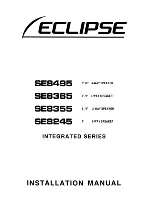
IN-WALL SPEAKERS
Please read the following instructions carefully before installing your Induction Dynamics
®
freestanding speakers. If you have
any questions regarding installation that are not answered in the following directions, please contact your local sound contractor
or the Induction Dynamics
®
/MSE Audio
®
technical support team. Contact information can be found on the back of the manual.
General Information
Your speakers and amplifier come in a high quality finish that is both attractive and durable. To clean, use a soft, damp cloth. If
your drivers become dusty, dust them with a paintbrush or a brush vacuum attachment. Do not use a strong or abrasive cleaner.
The grille is covered in acoustic cloth. To keep your grille clear of debris, we recommend you use a lint roller (like you would use
on clothes).
Do not use bass or loudness contour controls. Induction Dynamics’ subwoofers produce very low frequencies without these
controls. Use of these controls will make the bass sound “boomy”, obscure higher frequencies, and possibly cause damage
due to excessive cone excursion.
Speaker location: The in-wall speakers mount between wall studs and should be placed in accordance with the speaker’s
application (mains, surrounds, or stereo speakers).
The height of the speaker should be determined by locating the tweeter near ear level. The tweeter reproduces high-frequency
audio, which our ears perceive as most directional, so we are most attuned to their placement and level. As you make your
decision, consider whether people will be standing or sitting in the listening area. The speakers may be mounted upside down
(tweeter nearest floor) to achieve the proper tweeter level with the look of a higher mounted speaker.
Speaker Wiring: Use approved wire designed for in-wall or exposed use, as appropriate for your installation. For the in-walls,
we recommend using high-quality speaker wire that is 12 gauge or lower, with easily visible polarity coding to make your
connections. The following chart identifies minimum gauge requirements for various lengths. See your local dealer or installation
contractor for more information.
New Construction Installation
In new home construction, or with walls where drywall has not been applied, it is recommended that you wait until after the
drywall application before installing the easymount boxes for the following reasons:
1. The installer gains the control to cut a neat and accurate hole, eliminating possible mistakes by drywallers.
2. Drywall around the hole is more likely to be flat. This is especially true if any mudding is done in the vicinity of the hole. The
result is a cleaner final fit around the edges.
3. Possible shimming behind drywall can throw off depth calculations and final alignment of gasket with the face of the drywall.
Drywallers sometimes shim to level out the wall where studs are out of line.
4. Mud and construction dust is kept from getting into the box.
If circumstances require the easy-mount boxes to be installed prior to drywall, then be sure the gasket on the front of the boxes
protrudes out from the edge of the wall studs by an amount equal to the thickness of the drywall plus 1/4”. Alternatively, the
outside back of the metal box should be 3 7/8” back from the finished drywall surface.
Check for Obstacles Inside Walls
Check the home’s architectural blueprints to verify that your preferred mounting location is free from obstacles including extra
wall studs, electrical wires, plumbing, and heating ducts.
Locating the Loudspeaker Mounting Holes
1. To find wall studs, use a stud finder. The in-walls will mount between two studs and should be positioned so that the tweeter
is at ear level.
Length in Feet
Up to 18’
Up to 29’
Up to 51’
AWG Size & Stranding
14 Gauge (19/27)
12 Gauge (65/30)
10 Gauge (105/30)
Wire Length / Minimum Gauge
Require
ments
Wall studs
Center line
pencil mark
3” hole - centered
between wall studs
Cutout - centered
between wall studs
12 9/16” W x 60” H
2. When you’ve decided on a location, cut a 3” hole in the approximate center of the
proposed cutout area. Measure the exact distances from the left and right wall studs
from the inside of the wall, to establish the horizontal center line between the wall
studs and mark this with a pencil.
3. Place the mounting hole template flush against the wall. The template should be
centered between the wall studs, making sure that the left and right channels are the
same height.
4. Using a drywall knife or keyhole saw, carefully cut along the drawn line and remove
the cutout.
5. Before installing the easy-mount box into the walls, you will need to bring the
speaker wire into the mounting hole. Be sure to leave plenty of extra wire coming
into the mounting hole, especially if you are bringing in the wire from below since the
speaker wire access holes are at the top of the easy mount box.






















